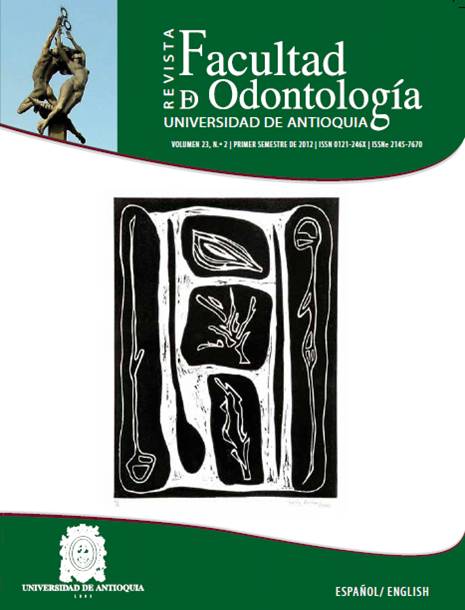Administración sistémica adjunta de moxifloxacina versus ciprofloxacina más metronidazol en el tratamiento de periodontitis crónica con presencia de bacilos entéricos Gram negativos: II. Análisis multinivel
DOI:
https://doi.org/10.17533/udea.rfo.10139Keywords:
Antimicrobial(s9, Periodontitis, Multinivel analysisAbstract
Introduction: the site, tooth, and patient levels are involved in the periodontal inflammatory process. The purpose of this study was to compare the effect of site, tooth, and patient-related factors on the success of scaling and root planing combined with systemic administration of moxifloxacin or ciprofloxacin plus metronidazole in the treatment of subjects with chronic periodontitis harboring Gramnegative enteric rods. Methods: seventy-six patients participated in this randomized clinical trial, divided into two groups. The subjects were treated with scaling and root planing plus adjunctive moxifloxacin (moxifloxacin group; n = 38) or scaling and root planing plus adjunctive ciprofloxacin plus metronidazole (ciprofloxacin plus metronidazole group; n = 38). Periodontal and microbiological data were recorded at baseline and at 3 and 6 months after treatment. The relative contribution of patient, tooth and site-associated parameters was evaluated with a hierarchical multilevel model. Results: most of the var ance was attributed to site level (73%), followed by tooth level (18.1%) and patient level (8.9%). The multilevel analysis associated probing depth reductions with subject factors (smoking status and treatment), tooth factors (tooth type), and site factors (mesial-distal location). Probing depth reduction was significantly smaller in smokers. Both treatment protocols significantly reduced probing depth. Anterior teeth responded better than posterior teeth. At the site level, greater reductions were observed at interdental sites. The presence of plaque and bleeding on probing at the tooth site level had a significant negative impact on the outcome of chronic periodontitis harboring Gram-negative enteric rods. Conclusions: smoking habits, tooth type, mesial-distal location, plaque and bleeding on probing at site level were significant factors in determining the clinical outcome of scaling and root planing plus adjunctive antibiotic treatment in chronic periodontitis harboring Gram-negative enteric rods.
Downloads
Downloads
Published
How to Cite
Issue
Section
Categories
License
Copyright (c) 2012 Revista Facultad de Odontología Universidad de Antioquia

This work is licensed under a Creative Commons Attribution-NonCommercial-ShareAlike 4.0 International License.
Copyright Notice
Copyright comprises moral and patrimonial rights.
1. Moral rights: are born at the moment of the creation of the work, without the need to register it. They belong to the author in a personal and unrelinquishable manner; also, they are imprescriptible, unalienable and non negotiable. Moral rights are the right to paternity of the work, the right to integrity of the work, the right to maintain the work unedited or to publish it under a pseudonym or anonymously, the right to modify the work, the right to repent and, the right to be mentioned, in accordance with the definitions established in article 40 of Intellectual property bylaws of the Universidad (RECTORAL RESOLUTION 21231 of 2005).
2. Patrimonial rights: they consist of the capacity of financially dispose and benefit from the work trough any mean. Also, the patrimonial rights are relinquishable, attachable, prescriptive, temporary and transmissible, and they are caused with the publication or divulgation of the work. To the effect of publication of articles in the journal Revista de la Facultad de Odontología, it is understood that Universidad de Antioquia is the owner of the patrimonial rights of the contents of the publication.
The content of the publications is the exclusive responsibility of the authors. Neither the printing press, nor the editors, nor the Editorial Board will be responsible for the use of the information contained in the articles.
I, we, the author(s), and through me (us), the Entity for which I, am (are) working, hereby transfer in a total and definitive manner and without any limitation, to the Revista Facultad de Odontología Universidad de Antioquia, the patrimonial rights corresponding to the article presented for physical and digital publication. I also declare that neither this article, nor part of it has been published in another journal.
Open Access Policy
The articles published in our Journal are fully open access, as we consider that providing the public with free access to research contributes to a greater global exchange of knowledge.
Creative Commons License
The Journal offers its content to third parties without any kind of economic compensation or embargo on the articles. Articles are published under the terms of a Creative Commons license, known as Attribution – NonCommercial – Share Alike (BY-NC-SA), which permits use, distribution and reproduction in any medium, provided that the original work is properly cited and that the new productions are licensed under the same conditions.
![]()
This work is licensed under a Creative Commons Attribution-NonCommercial-ShareAlike 4.0 International License.













